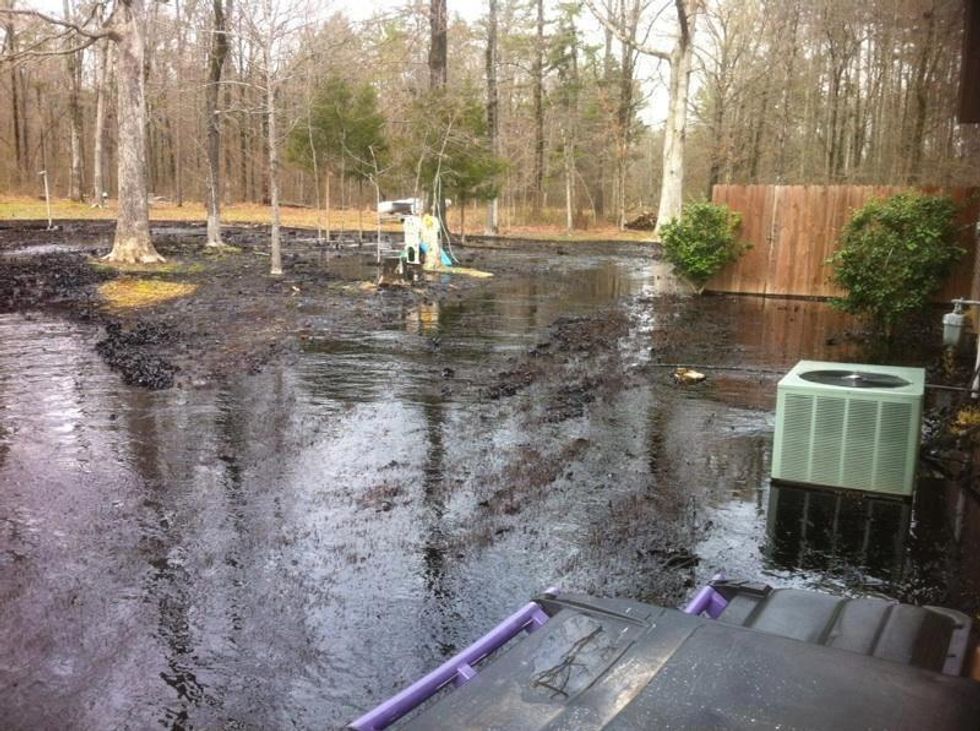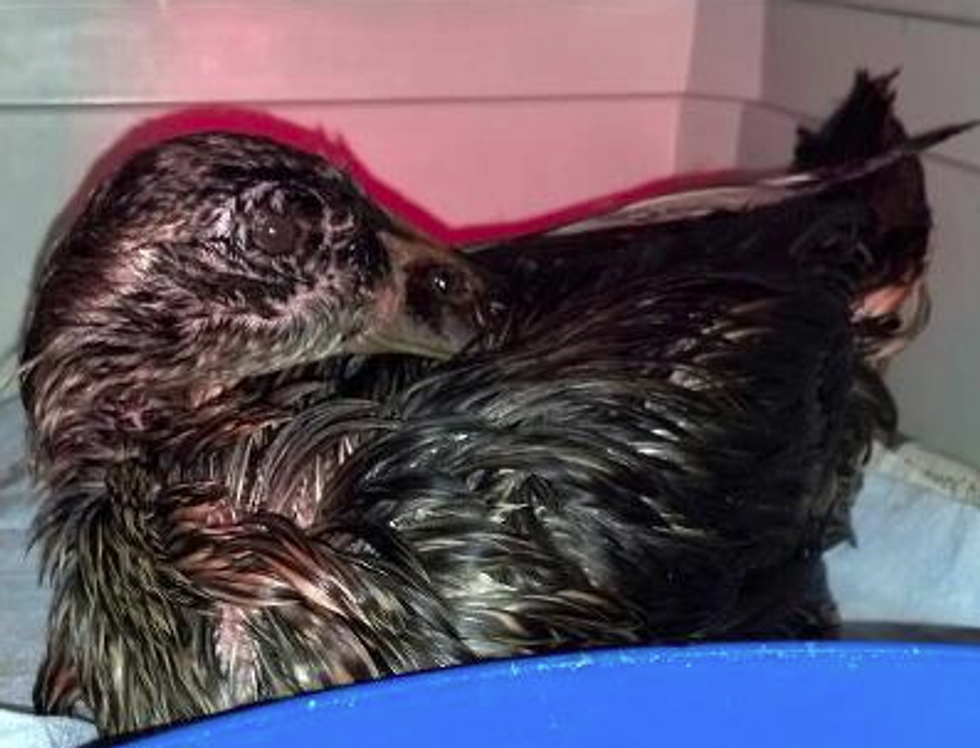Apr 01, 2013

Though the exact amount of spilled oil remains unknown, as the National Wildlife Federation writes, "just as we saw in the early days of BP's Gulf oil disaster, the number is growing exponentially each day."
"Exxon Mobil officials said the total amount of water and oil pumped out of a Mayflower subdivision nearly tripled Sunday, reaching 12,000 barrels, or 504,000 gallons, compared with estimates on Saturday that crews had pumped 4,500 barrels," reports the Arkansas Democrat-Gazette Monday morning.
Though the cleaning crews have reportedly removed most of the freestanding oil which covered the neighborhood streets, local news station KATV touring the area on Sunday, said that removing the crude from individual's backyards promises to be "a much more challenging project to take on."
"This is going to be an extensive and long cleanup," said onsite EPA coordinator Nicolas Brescia. "Right now, the goal is to pick up as much free product as they can." He added, "I can't tell you how long it's going to take to clean up all the impacted areas."
"The Mayflower tar sands spill is yet another demonstration of the risks that tar sands pipelines pose to the communities and sensitive water resources they cross," writes Anthony Swift of the Natural Resources Defense Council, adding that the spill is also a warning of "the potential costs of the tar sands industry's reckless expansion plans."
Environmentalists are pointing to the Mayflower rupture as further evidence that the authorization of the Keystone XL tar sands pipeline would pose "significant risk" to our communities and ecosystems.
"We'd be wise to think about this as one more sad warning," said 350.org founder Bill McKibben, in a statement responding to the spill. "What the people of Arkansas are enduring today is a reminder of why approving KXL, a pipeline ten times as large and running across the Oglalla Aquifer, defines a bad idea."
The greatest priority in the Mayflower clean up still appears to be preventing the oil from traveling through the community's storm drain system to Lake Conway, a large man made recreation reservoir stocked with bass, catfish, bream and crappie. The National Wildlife Federation reports that local authorities built several earthen dams to try to prevent the tar sands oil from reaching the lake, "but if the water is fouled," they said, "it won't just threaten the fish, it will threaten the area's recreation economy."
Local animal wildlife rehabilitation clinic, the HAWK center, posted images on their facebook page of recovered birds coated with the thick, black tar.
"We anticipate a LOT more patients today," they write.

As of Sunday evening, officials from neither the town or the energy giant behind the spill were able to provide answers to the 22 evacuated households as to when they would be able to return home or why the spill occurred. An investigation is reportedly underway.
Tweets about "arkansas oil spill"
__________________________
Join Us: News for people demanding a better world
Common Dreams is powered by optimists who believe in the power of informed and engaged citizens to ignite and enact change to make the world a better place. We're hundreds of thousands strong, but every single supporter makes the difference. Your contribution supports this bold media model—free, independent, and dedicated to reporting the facts every day. Stand with us in the fight for economic equality, social justice, human rights, and a more sustainable future. As a people-powered nonprofit news outlet, we cover the issues the corporate media never will. Join with us today! |
Our work is licensed under Creative Commons (CC BY-NC-ND 3.0). Feel free to republish and share widely.
Lauren McCauley
Lauren McCauley is a former senior editor for Common Dreams covering national and international politics and progressive news. She is now the Editor of Maine Morning Star. Lauren also helped produce a number of documentary films, including the award-winning Soundtrack for a Revolution and The Hollywood Complex, as well as one currently in production about civil rights icon James Meredith. Her writing has been featured on Newsweek, BillMoyers.com, TruthDig, Truthout, In These Times, and Extra! the newsletter of Fairness and Accuracy in Reporting. She currently lives in Kennebunk, Maine with her husband, two children, a dog, and several chickens.

Though the exact amount of spilled oil remains unknown, as the National Wildlife Federation writes, "just as we saw in the early days of BP's Gulf oil disaster, the number is growing exponentially each day."
"Exxon Mobil officials said the total amount of water and oil pumped out of a Mayflower subdivision nearly tripled Sunday, reaching 12,000 barrels, or 504,000 gallons, compared with estimates on Saturday that crews had pumped 4,500 barrels," reports the Arkansas Democrat-Gazette Monday morning.
Though the cleaning crews have reportedly removed most of the freestanding oil which covered the neighborhood streets, local news station KATV touring the area on Sunday, said that removing the crude from individual's backyards promises to be "a much more challenging project to take on."
"This is going to be an extensive and long cleanup," said onsite EPA coordinator Nicolas Brescia. "Right now, the goal is to pick up as much free product as they can." He added, "I can't tell you how long it's going to take to clean up all the impacted areas."
"The Mayflower tar sands spill is yet another demonstration of the risks that tar sands pipelines pose to the communities and sensitive water resources they cross," writes Anthony Swift of the Natural Resources Defense Council, adding that the spill is also a warning of "the potential costs of the tar sands industry's reckless expansion plans."
Environmentalists are pointing to the Mayflower rupture as further evidence that the authorization of the Keystone XL tar sands pipeline would pose "significant risk" to our communities and ecosystems.
"We'd be wise to think about this as one more sad warning," said 350.org founder Bill McKibben, in a statement responding to the spill. "What the people of Arkansas are enduring today is a reminder of why approving KXL, a pipeline ten times as large and running across the Oglalla Aquifer, defines a bad idea."
The greatest priority in the Mayflower clean up still appears to be preventing the oil from traveling through the community's storm drain system to Lake Conway, a large man made recreation reservoir stocked with bass, catfish, bream and crappie. The National Wildlife Federation reports that local authorities built several earthen dams to try to prevent the tar sands oil from reaching the lake, "but if the water is fouled," they said, "it won't just threaten the fish, it will threaten the area's recreation economy."
Local animal wildlife rehabilitation clinic, the HAWK center, posted images on their facebook page of recovered birds coated with the thick, black tar.
"We anticipate a LOT more patients today," they write.

As of Sunday evening, officials from neither the town or the energy giant behind the spill were able to provide answers to the 22 evacuated households as to when they would be able to return home or why the spill occurred. An investigation is reportedly underway.
Tweets about "arkansas oil spill"
__________________________
Lauren McCauley
Lauren McCauley is a former senior editor for Common Dreams covering national and international politics and progressive news. She is now the Editor of Maine Morning Star. Lauren also helped produce a number of documentary films, including the award-winning Soundtrack for a Revolution and The Hollywood Complex, as well as one currently in production about civil rights icon James Meredith. Her writing has been featured on Newsweek, BillMoyers.com, TruthDig, Truthout, In These Times, and Extra! the newsletter of Fairness and Accuracy in Reporting. She currently lives in Kennebunk, Maine with her husband, two children, a dog, and several chickens.

Though the exact amount of spilled oil remains unknown, as the National Wildlife Federation writes, "just as we saw in the early days of BP's Gulf oil disaster, the number is growing exponentially each day."
"Exxon Mobil officials said the total amount of water and oil pumped out of a Mayflower subdivision nearly tripled Sunday, reaching 12,000 barrels, or 504,000 gallons, compared with estimates on Saturday that crews had pumped 4,500 barrels," reports the Arkansas Democrat-Gazette Monday morning.
Though the cleaning crews have reportedly removed most of the freestanding oil which covered the neighborhood streets, local news station KATV touring the area on Sunday, said that removing the crude from individual's backyards promises to be "a much more challenging project to take on."
"This is going to be an extensive and long cleanup," said onsite EPA coordinator Nicolas Brescia. "Right now, the goal is to pick up as much free product as they can." He added, "I can't tell you how long it's going to take to clean up all the impacted areas."
"The Mayflower tar sands spill is yet another demonstration of the risks that tar sands pipelines pose to the communities and sensitive water resources they cross," writes Anthony Swift of the Natural Resources Defense Council, adding that the spill is also a warning of "the potential costs of the tar sands industry's reckless expansion plans."
Environmentalists are pointing to the Mayflower rupture as further evidence that the authorization of the Keystone XL tar sands pipeline would pose "significant risk" to our communities and ecosystems.
"We'd be wise to think about this as one more sad warning," said 350.org founder Bill McKibben, in a statement responding to the spill. "What the people of Arkansas are enduring today is a reminder of why approving KXL, a pipeline ten times as large and running across the Oglalla Aquifer, defines a bad idea."
The greatest priority in the Mayflower clean up still appears to be preventing the oil from traveling through the community's storm drain system to Lake Conway, a large man made recreation reservoir stocked with bass, catfish, bream and crappie. The National Wildlife Federation reports that local authorities built several earthen dams to try to prevent the tar sands oil from reaching the lake, "but if the water is fouled," they said, "it won't just threaten the fish, it will threaten the area's recreation economy."
Local animal wildlife rehabilitation clinic, the HAWK center, posted images on their facebook page of recovered birds coated with the thick, black tar.
"We anticipate a LOT more patients today," they write.

As of Sunday evening, officials from neither the town or the energy giant behind the spill were able to provide answers to the 22 evacuated households as to when they would be able to return home or why the spill occurred. An investigation is reportedly underway.
Tweets about "arkansas oil spill"
__________________________
We've had enough. The 1% own and operate the corporate media. They are doing everything they can to defend the status quo, squash dissent and protect the wealthy and the powerful. The Common Dreams media model is different. We cover the news that matters to the 99%. Our mission? To inform. To inspire. To ignite change for the common good. How? Nonprofit. Independent. Reader-supported. Free to read. Free to republish. Free to share. With no advertising. No paywalls. No selling of your data. Thousands of small donations fund our newsroom and allow us to continue publishing. Can you chip in? We can't do it without you. Thank you.